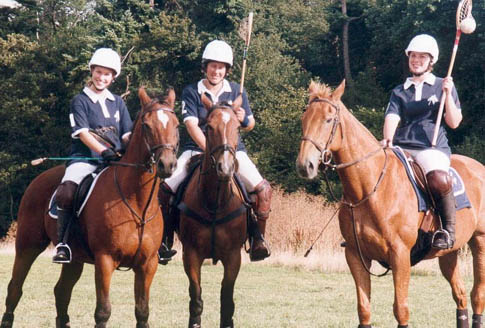HOW TO PLAY POLOCROSSE
Polocrosse is a cross between polo and lacrosse played on horseback.
It is a fast, adrenalin-fuelled sport played across the country and throughout
the world. The sport combines speed, agility and skill with excellent horsemanship
and unlike polo; both right and left-handed men and women of any age can play
polocrosse.

The
sport is played on a pitch similar in size to a football field, 145.5m long
by 55m wide with 5m high goalposts, 2.5m apart at each end. It is divided
into three sections with the end goal-scoring areas 27.5m in length with a
10m semi-circular zone in which a goal cannot be scored.
Players use racquets with a wooden shaft and handle but the head can be either
wooden, plastic or graphite depending on a player’s individual preference.
The racquet is just over one metre in length and the head has a loose string
net in which a rubber-coated sponge ball, slightly smaller than a mini football
fits. The ball is scooped up, carried, caught and thrown between players to
transport it up and down the pitch.

TEAM
Each
team is made up of two sections consisting of three players, numbered 1, 2
and 3, all of who have different roles. Only the attacking number 1 and defending
number 3 are allowed in the end goal scoring areas, however, every player
is allowed in the middle area.
The number 1 is the attacker and is the only player on each team who can score
a goal because they are the only position allowed in the attacking and centre
thirds. To score they must be in their attacking goal scoring area and have
to throw the ball between the two posts from outside the semi-circle.
The number 2 is the midfielder and is only allowed in the central third of
the pitch. Their job is to help win possession if the opposition has the ball
or to take out a member of the opposition if their own team has the ball.
The number 3 is the defender and as they are the only other player allowed
in the same end third as their opposing number 1 it is their job to try and
prevent the opposition from scoring. This is done by hassling, tackling, pushing
the number 1 out of the area and generally getting in the way.
CHUKKA
A
chukka lasts either six or eight minutes and a match consists of six or eight
chukkas with each section playing alternatively. The sections’ scores
are added together for the final match score.
The chukka begins in the centre area where the two teams line up next to each
other on the “Ts” facing the sideline.

Each team attacks at the end furthest away from them at the line-up. The game
begins when one of the two mounted umpires throws the ball in down the centre
of the lineout above the players’ heads.
Once possession has been won by either catching the ball in the line-out or
scooping it up off the ground, the ball can be passed between players to get
it to the number 1 to try and score. However, the ball must not be carried
across the line into an area, it must be either passed or bounced across.
A player can be tackled by hitting their racquet in an upward direction to
try and dislodge the ball. This must be done avoiding contact with the horse
or the opponent’s head or body as this and a downward-motioned tackle
are fouls and will result in penalties to the opposition.
Another method of winning possession is by “riding off” an opponent.
This is done by making your horse’s shoulder push against an opponent’s
horse’s shoulder, therefore moving them away from the ball. If this is
done when they already have the ball and they are pushed over a side or back
line, a free 10m throw is given to the opposition.
Once a goal has been scored the teams return to the “T” on the opposite
side of the pitch for another lineout.
![]()